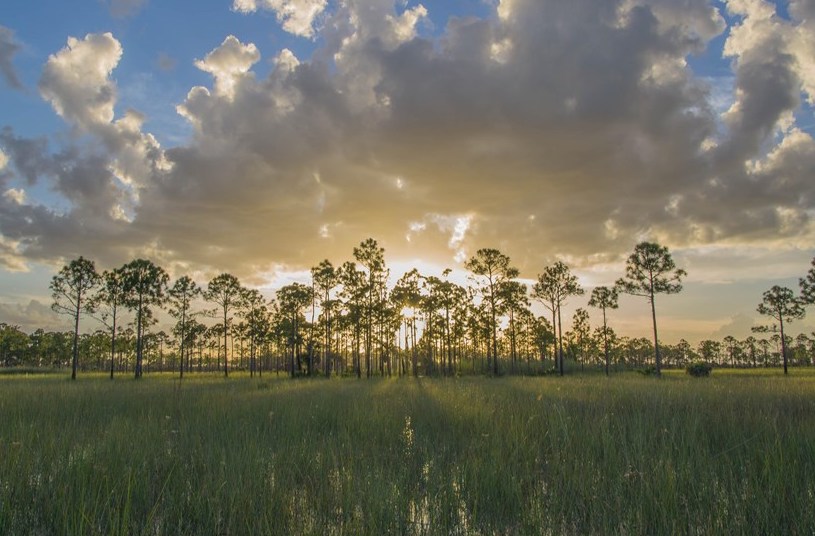Big Cypress National Preserve. Photo: National Park Service
By Chris Santella
Phoenix, Arizona has an average rainfall of 12.03” and an average humidity of 36 percent. There have been no confirmed sightings of tarpon, bonefish or permit in the region since the city was established in 1881.
Big Cypress National Preserve (the swampy habitat that’s bifurcated much of its length by I-75) sees more than four times as much rain each year and humidity you can cut with a knife. There’s nary a cactus in sight.
Yet these two incredibly disparate landscapes were forever linked in an out-of-the-box land swap that conserved over 100,000 acres of environmentally sensitive land adjoining the Everglades, helping to protect southwest Florida’s watersheds, and threatened Florida panthers alike…and creating Ten Thousand Islands National Wildlife Refuge.
BTT Vice Chairman Bill Horn was there 35 years ago, and helped engineer one of America’s most innovative conservation land deals.
In 1985, Horn was tapped to be Assistant Secretary for Fish and Wildlife, Department of the Interior. One of his goals was to put more critical wildlife habitat under protection. “The Reagan Administration was being very tight-fisted on domestic appropriations, especially for land,” Horn recounted. “It occurred to me that there must be other ways to secure land beyond seeking appropriations. What if we used other federal assets to fund acquisitions? This way, we secure the land without increasing the deficit.”
It was just around this time that Horn received a call from the Barron Collier Company, a major Florida developer and landholder, requesting a meeting. “The Colliers owned all this land adjacent to Big Cypress National Preserve and the Everglades,” Horn continued. “They knew it was valuable for Florida panther protection, and thought the Department of the Interior would like to buy it. But we didn’t have any money, and I knew it would take us forever to get the dollars appropriated through Congress. [At the time, the land was valued at $45.1 million.] But I’d been looking at the Everglades and some the water issues there. I told them that we might have another piece of real estate that might be of interest to them if we were to conduct a swap; let me look around and I’ll get back to you.”
It turned out that the Bureau of Indian Affairs (another branch of the Department of the Interior) was closing down the Phoenix Indian School, which served Native American students in the region. The property comprised roughly 100 acres north of downtown Phoenix, and Horn thought this might be of interest to the Colliers.
“I went to my boss [Secretary of the Interior Donald Hodel] and said, ‘Don, you’d better sit down. I have an interesting idea, another way to skin the conservation cat.’ He liked the idea of the land swap, though the Assistant Secretary for Indian Affairs [Ross Swimmers] wasn’t thrilled. The swapping idea wasn’t completely unprecedented. We’d negotiated a few deals like this in Alaska with Native corporations. But because this was an interstate deal, congressional approval was necessary.”
Horn chuckles as he recalls the politics around what came to be known as the Arizona-Florida Land Exchange Act of 1988. “Arizona Senator [Barry] Goldwater hated the legislation. He said it was the stupidest thing he’d ever heard, the idea that good property in Phoenix would be given up for swamp water. But then John McCain was elected to the Senate. He and Arizona Representative Mo Udall both became backers. In the end, more support came out of Arizona then from Florida.”
The Arizona-Florida Land Exchange Act (Public Law 100-696) was enacted on November 18, 1988. Over 108,000 acres of land were passed from the Colliers to the Department of the Interior, and allocated as follows:
- 85,000 acres were added to the Big Cypress Preserve
- 15,00 acres created the Ten Thousand Islands National Wildlife Refuge
- 7,500 acres were added to the Florida Panther National Wildlife Refuge
Mangrove and riverine habitat that’s essential for the Southwest Florida’s aquatic life was thus protected in perpetuity.
There was also a happy denouement for Native Americans and Phoenicians. The Phoenix Indian School property was appraised at a higher value than the Florida land, and the Colliers paid the Department of the Interior an additional $34.9 million as part of the deal. This money was set aside for two Native American educational trust funds. The Colliers ended up trading the 108 acres they’d acquired in the Florida swap with the City of Phoenix for 20-odd acres near the downtown area. Much of the former site of the Phoenix Indian School is now a city park for everyone to enjoy.
Chris Santella is the author of 21 books, including the popular “Fifty Places” series from Abrams. He’s a regular contributor to The New York Times, The Washington Post, and Trout.




